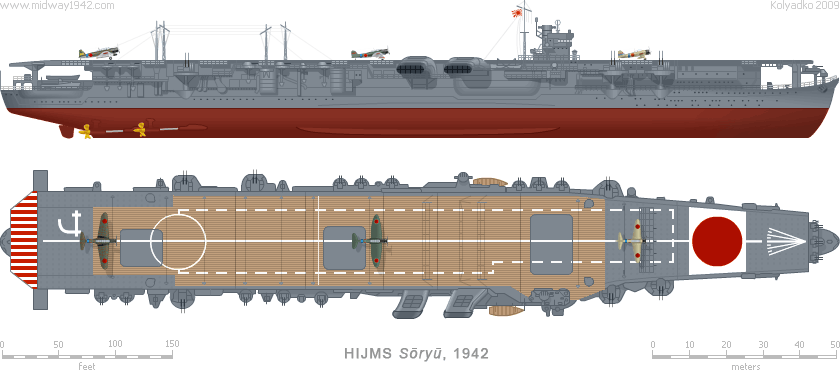
| Sōryū, 蒼龍 | AIRCRAFT CARRIER, 航空母艦 | |

| Displacement: | 18,800 t (15,900 t Std) | Machinery: | 8 boilers, 4 shafts | Flight Deck: | 711 ft 6 in 216.8 m | Armor: | 1.8 in (46 mm) belt | |||||||||
|---|---|---|---|---|---|---|---|---|---|---|---|---|---|---|---|---|
| Max Length: | 746 ft 5 in | 227.5 m | Max Power: | 152,000 hp | 113 336 kW | Fighters: | 27× A6M2 Type 0 | SP Guns: | — | |||||||
| Beam: | 69 ft 11 in | 21.3 m | Max Speed: | 34.5 kts | 63.89 km/h | Bombers: | 18× D3A1 Type 99 | DP Guns: | 6× 2× 5 in (127 mm)/40 | |||||||
| Draght: | 25 ft 0 in | 7.6 m | Range: | 7,750 nm | 14 353 km | Attack: | 18× B5N2 Type 97 | AA Guns: | 14× 2× 0.98 in (25 mm) | |||||||
* Aircraft as in the largest known Air Group ever carried (during the Pearl Harbor raid).
Sōryū was laid down on 20 November 1934 at Kure Naval Dockyard and commissioned on 29 December 1937. As opposed to earlier Japanese fleet carriers which were redesigns on battlecruiser or battleship hulls, she was the first designed from the keel as an aircraft carrier and established the basic format for all future Japanese carrier classes: a high-aspect cruiser like hull mounting powerful machinery for high speed, two hangar decks (with lower one faired into the structure of the hull) served by three elevators, light construction, and little or no armor protection.
As the flagship of Carrier Division 2, Sōryū was active off China. During the opening stages of the Pacific War, she took part in the attack on Pearl Harbor, Wake, Palau Islands, Darwin, Indian Ocean raids, and the battle of Midway, where she was hit by three aerial bombs at 1023, 4 June 1942. The hits caused massive fires and secondary explosions among fueled and armed aircraft on the hangar decks. Twenty-three minutes after the attack the crew was ordered to abandon Sōryū. The ship sank (probably scuttled by torpedoes from her escort destroyer) at 1912, 4 June 1942, at position 30°42' N 179°37' W.